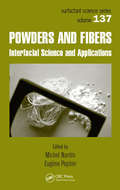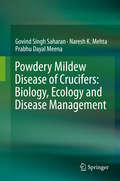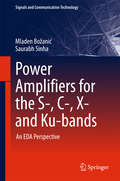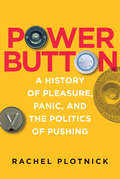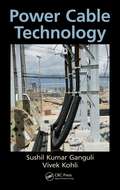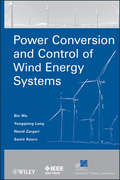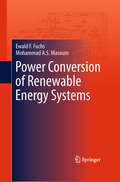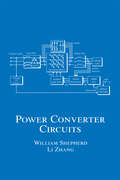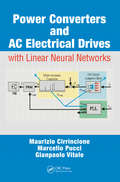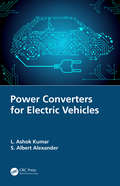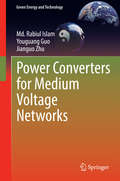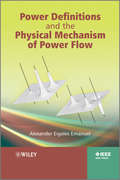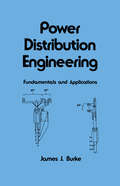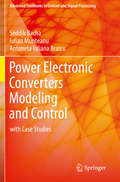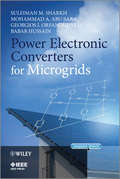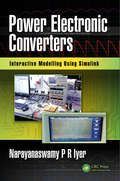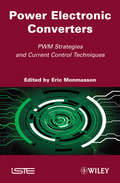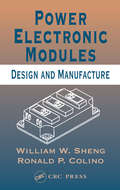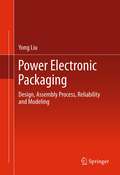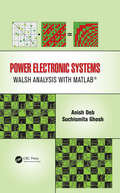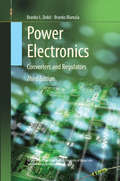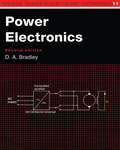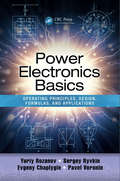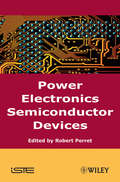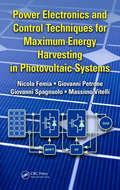- Table View
- List View
Powders and Fibers: Interfacial Science and Applications (Surfactant Science #137)
by Michel Nardin Eugène PapirerNew analytical methods have provided further insight into the structure, surface characteristics, and chemistries of increasingly small particles. However, current literature offers information on only a limited number of powders being investigated. Written by renowned scientists in the field, Powders and Fibers: Interfacial Science and Application
Powdery Mildew Disease of Crucifers: Biology, Ecology and Disease Management
by Govind Singh Saharan Prabhu Dayal Meena Naresh K. MehtaPowdery mildew disease is the fourth most widespread disease in cruciferous crops and a devastating effect, causing significant losses in terms of quality and quantity in rapeseed and mustard. Powdery mildews are also a favourable host-pathosystem model for basic research on host–parasite interactions, developmental morphology, cytology, and molecular biology to identify the effector proteins/genes governing different biological functions. This book provides a comprehensive overview of all the published information in the field for researchers, teachers, students, extension experts, industrialists and farmers, and includes illustrations, photographs, graphs, figures, tables, histograms, micrographs, electron micrographs, and flow charts to aid understanding. It also describes standardized reducible techniques. The book discusses each disease in detail, describing the distribution, symptomatology, host range, yield losses and disease assessment, as well as the taxonomy, morphology, phylogeny, variability, sporulation, survival and perpetuation of the pathogen. Further, it explores topics such as spore germination; infection; pathogenesis; disease cycle; epidemiology; forecasting; fine structures; host resistance; biochemical, histological, genetic and molecular aspects such as cloning and mapping of R genes; sources of resistance; disease resistance breeding; and the genetics of host-parasite interactions and disease management.
Power Amplifiers for the S-, C-, X- and Ku-bands
by Saurabh Sinha Mladen BožanićThis book provides a detailed review of power amplifiers, including classes and topologies rarely covered in books, and supplies sufficient information to allow the reader to design an entire amplifier system, and not just the power amplification stage. A central aim is to furnish readers with ideas on how to simplify the design process for a preferred power amplifier stage by introducing software-based routines in a programming language of their choice. The book is in two parts, the first focusing on power amplifier theory and the second on EDA concepts. Readers will gain enough knowledge of RF and microwave transmission theory, principles of active and passive device design and manufacturing, and power amplifier design concepts to allow them to quickly create their own programs, which will help to accelerate the transceiver design process. All circuit designers facing the challenge of designing an RF or microwave power amplifier for frequencies from 2 to 18 GHz will find this book to be a valuable asset.
Power Button: A History of Pleasure, Panic, and the Politics of Pushing
by Rachel PlotnickPush a button and turn on the television; tap a button and get a ride; click a button and “like” something. The touch of a finger can set an appliance, a car, or a system in motion, even if the user doesn't understand the underlying mechanisms or algorithms. How did buttons become so ubiquitous? Why do people love them, loathe them, and fear them? In Power Button, Rachel Plotnick traces the origins of today's push-button society by examining how buttons have been made, distributed, used, rejected, and refashioned throughout history. Focusing on the period between 1880 and 1925, when “technologies of the hand” proliferated (including typewriters, telegraphs, and fingerprinting), Plotnick describes the ways that button pushing became a means for digital command, which promised effortless, discreet, and fool-proof control. Emphasizing the doubly digital nature of button pushing—as an act of the finger and a binary activity (on/off, up/down)—Plotnick suggests that the tenets of precomputational digital command anticipate contemporary ideas of computer users. Plotnick discusses the uses of early push buttons to call servants, and the growing tensions between those who work with their hands and those who command with their fingers; automation as “automagic,” enabling command at a distance; instant gratification, and the victory of light over darkness; and early twentieth-century imaginings of a future push-button culture. Push buttons, Plotnick tells us, have demonstrated remarkable staying power, despite efforts to cast button pushers as lazy, privileged, and even dangerous.
Power Cable Technology
by Sushil Kumar Ganguli Vivek KohliPower Cable Technology provides a precise understanding of the design, manufacture, installation, and testing of a range of electric power cables—from low-voltage, 1,000/1,100V cables to extra-high-voltage, 400kV cables—with reference to future trends in the industry. The authors’ mantra is: know your cable. Thus, the book begins with a comprehensive overview of power cable design and manufacturing through the ages, and then: Describes the characteristics of the materials currently used in the production of various power cables Explains how to calculate the die orifice for drawing wires, how tolerance in manufacturing affects material weight and consumption, and how and why lubricants are used Addresses the formation, stranding, and insulation of the electrical conductors, as well as the sheathing, armouring, and protective covering of the power cables Delivers an in-depth discussion of quality systems, quality control, and performance testing Covers the many nuances of cable installation, including laying, jointing, and terminating Throughout, the authors emphasise consonance between design theory and practical application to ensure production of a quality power cable at a reasonable cost. They also underscore the importance of careful handling, making Power Cable Technology a must read for power cable engineers and technicians alike.
Power Conversion and Control of Wind Energy Systems
by Samir Kouro Navid Zargari Yongqiang Lang Bin WuThe book presents the latest power conversion and control technology in modern wind energy systems. <P><P>It has nine chapters, covering technology overview and market survey, electric generators and modeling, power converters and modulation techniques, wind turbine characteristics and configurations, and control schemes for fixed- and variable-speed wind energy systems. The book also provides in-depth steady-state and dynamic analysis of squirrel cage induction generator, doubly fed induction generator, and synchronous generator based wind energy systems. To illustrate the key concepts and help the reader tackle real-world issues, the book contains more than 30 case studies and 100 solved problems in addition to simulations and experiments. The book serves as a comprehensive reference for academic researchers and practicing engineers. It can also be used as a textbook for graduate students and final year undergraduate students.
Power Conversion of Renewable Energy Systems
by Mohammad A.S. Masoum Ewald F. FuchsPower Conversion of Renewable Energy Systems presents an introduction to conventional energy conversion components and systems, as well as those related to renewable energy. This volume introduces systems first, and then in subsequent chapters describes the components of energy systems in detail. Readers will find examples of renewable and conventional energy and power systems, including energy conversion, variable-speed drives and power electronics, in addition to magnetic devices such as transformers and rotating machines. Applications of PSpice, MATLAB, and Mathematica are also included, along with solutions to over 100 application examples. Power Conversion of Renewable Energy Systems aims to instruct readers how to actively apply the theories discussed within. It would be an ideal volume for researchers, students and engineers working with energy systems and renewable energy.
Power Converter Circuits (Electrical Engineering And Electronics Ser. #Vol. 119)
by William Shepherd Li ZhangThis text reveals all key components of rectification, inversion, cycloconversion, and conversion circuits. It authoritatively describes switching, voltage and current relationships, and converter properties, operation, control, and performance as utilized in most practical applications. Authored jointly by a veteran scholar and an accomplished res
Power Converters and AC Electrical Drives with Linear Neural Networks (Energy, Power Electronics, and Machines)
by Gianpaolo Vitale Maurizio Cirrincione Marcello PucciThe first book of its kind, Power Converters and AC Electrical Drives with Linear Neural Networks systematically explores the application of neural networks in the field of power electronics, with particular emphasis on the sensorless control of AC drives. It presents the classical theory based on space-vectors in identification, discusses control of electrical drives and power converters, and examines improvements that can be attained when using linear neural networks. The book integrates power electronics and electrical drives with artificial neural networks (ANN). Organized into four parts, it first deals with voltage source inverters and their control. It then covers AC electrical drive control, focusing on induction and permanent magnet synchronous motor drives. The third part examines theoretical aspects of linear neural networks, particularly the neural EXIN family. The fourth part highlights original applications in electrical drives and power quality, ranging from neural-based parameter estimation and sensorless control to distributed generation systems from renewable sources and active power filters. Simulation and experimental results are provided to validate the theories. Written by experts in the field, this state-of-the-art book requires basic knowledge of electrical machines and power electronics, as well as some familiarity with control systems, signal processing, linear algebra, and numerical analysis. Offering multiple paths through the material, the text is suitable for undergraduate and postgraduate students, theoreticians, practicing engineers, and researchers involved in applications of ANNs.
Power Converters for Electric Vehicles
by L. Ashok Kumar S. Albert AlexanderPower Converters for Electric Vehicles gives an overview, topology, design, and simulation of different types of converters used in electric vehicles (EV). It covers a wide range of topics ranging from the fundamentals of EV, Hybrid EV and its stepwise approach, simulation of the proposed converters for real-time applications and corresponding experimental results, performance improvement paradigms, and overall analysis. Drawing upon the need for novel converter topologies, this book provides the complete solution for the power converters for EV applications along with simulation exercises and experimental results. It explains the need for power electronics in the improvement of performance in EV. This book: Presents exclusive information on the power electronics of EV including traction drives. Provides step-by-step procedure for converter design. Discusses various topologies having different isolated and non-isolated converters. Describes control circuit design including renewable energy systems and electrical drives. Includes practical case studies incorporated with simulation and experimental results. Power Converters for Electric Vehicles will provide researchers and graduate students in Power Electronics, Electric Drives, Vehicle Engineering a useful resource for stimulating their efforts in this important field of the search for renewable technologies.
Power Converters for Medium Voltage Networks
by Jianguo Zhu Youguang Guo Md. Rabiul IslamThis book examines a number of topics, mainly in connection with advances in semiconductor devices and magnetic materials and developments in medium and large-scale renewable power plant technologies, grid integration techniques and new converter topologies, including advanced digital control systems for medium-voltage networks. The book's individual chapters provide an extensive compilation of fundamental theories and in-depth information on current research and development trends, while also exploring new approaches to overcoming some critical limitations of conventional grid integration technologies. Its main objective is to present the design and implementation processes for medium-voltage converters, allowing the direct grid integration of renewable power plants without the need for step-up transformers.
Power Definitions and the Physical Mechanism of Power Flow
by Alexander Eigeles EmanuelProfessor Emanuel uses clear presentation to compare and facilitate understanding of two seminal standards, The IEEE Std. 1459 and The DIN 40110-2:2002-11. Through critical analysis of the most important and recent theories and review of basic concepts, a highly accessible guide to the essence of the standards is presented.Key features:Explains the physical mechanism of energy flow under different conditions: single- and three-phase, sinusoidal and nonsinusoidal, balanced and unbalanced systems Starts at an elementary level and becomes more complex, with six core chapters and six appendices to clarify the mathematical aspects Discusses and recommends power definitions that played a significant historical role in paving the road for the two standards Provides a number of original unsolved problems at the end of each chapter Introduces a new nonactive power; the Randomness power. Power Definitions and the Physical Mechanism of Power Flow is useful for electrical engineers and consultants involved in energy and power quality. It is also helpful to engineers dealing with energy flow quantification, design and manufacturing of metering instrumentation; consultants working with regulations related to renewable energy courses and the smart grid; and electric utility planning and operation engineers dealing with energy bill structure. The text is also relevant to university researchers, professors, and advanced students in power systems, power quality and energy related courses.
Power Distribution Engineering: Fundamentals and Applications (Electrical and Computer Engineering #Vol. 88)
by James J. Burke"Covering virtually all areas of distribution engineering, this complete reference work examines the unique behavior of utilities and provides the practical knowledge necessary to solve real-world distribution problems. "
Power Electronic Converters Modeling and Control
by Seddik Bacha Iulian Munteanu Antoneta Iuliana BratcuModern power electronic converters are involved in a very broad spectrum of applications: switched-mode power supplies, electrical-machine-motion-control, active power filters, distributed power generation, flexible AC transmission systems, renewable energy conversion systems and vehicular technology, among them. Power Electronics Converters Modeling and Control teaches the reader how to analyze and model the behavior of converters and so to improve their design and control. Dealing with a set of confirmed algorithms specifically developed for use with power converters, this text is in two parts: models and control methods. The first is a detailed exposition of the most usual power converter models: · switched and averaged models; · small/large-signal models; and · time/frequency models. The second focuses on three groups of control methods: · linear control approaches normally associated with power converters; · resonant controllers because of their significance in grid-connected applications; and · nonlinear control methods including feedback linearization, stabilizing, passivity-based, and variable-structure control. Extensive case-study illustration and end-of-chapter exercises reinforce the study material. Power Electronics Converters Modeling and Control addresses the needs of graduate students interested in power electronics, providing a balanced understanding of theoretical ideas coupled with pragmatic tools based on control engineering practice in the field. Academics teaching power electronics will find this an attractive course text and the practical points make the book useful for self tuition by engineers and other practitioners wishing to bring their knowledge up to date.
Power Electronic Converters for Microgrids (Wiley - IEEE)
by Georgios I. Orfanoudakis Babar Hussain Suleiman M. Sharkh Mohammad A. Abu-SaraAs concerns about climate change, energy prices, and energy security loom, regulatory and research communities have shown growing interest in alternative energy sources and their integration into distributed energy systems. However, many of the candidate microgeneration and associated storage systems cannot be readily interfaced to the 50/60 Hz grid. In Power Electronic Converters for Microgrids, Sharkh and Abu-Sara introduce the basics and practical concerns of analyzing and designing such micro-generation grid interface systems. Readers will become familiar with methods for stably feeding the larger grid, importing from the grid to charge on-site storage, disconnecting from the grid in case of grid failure, as well as connect multiple microgrids while sharing their loads appropriately. Sharkh and Abu-Sara introduce not only the larger context of the technology, but also present potential future applications, along with detailed case studies and tutorials to help the reader effectively engineer microgrid systems.
Power Electronic Converters: Interactive Modelling Using Simulink
by Narayanaswamy P IyerProvides a step-by-step method for the development of a virtual interactive power electronics laboratory. The book is suitable for undergraduates and graduates for their laboratory course and projects in power electronics. It is equally suitable for professional engineers in the power electronics industry. The reader will learn to develop interactive virtual power electronics laboratory and perform simulations of their own, as well as any given power electronic converter design using SIMULINK with advanced system model and circuit component level model. <P><P> Features <P><P> Examples and Case Studies included throughout. <P><P> Introductory simulation of power electronic converters is performed using either PSIM or MICROCAP Software. <P><P> Covers interactive system model developed for three phase Diode Clamped Three Level Inverter, Flying Capacitor Three Level Inverter, Five Level Cascaded H-Bridge Inverter, Multicarrier Sine Phase Shift PWM and Multicarrier Sine Level Shift PWM. <P><P> System models of power electronic converters are verified for performance using interactive circuit component level models developed using Simscape-Electrical, Power Systems and Specialized Technology block set. <P><P> Presents software in the loop or Processor in the loop simulation with a power electronic converter examples.
Power Electronic Converters: PWM Strategies and Current Control Techniques (Wiley-iste Ser.)
by Eric MonmassonA voltage converter changes the voltage of an electrical power source and is usually combined with other components to create a power supply. This title is devoted to the control of static converters, which deals with pulse-width modulation (PWM) techniques, and also discusses methods for current control. Various application cases are treated. The book is ideal for professionals in power engineering, power electronics, and electric drives industries, as well as practicing engineers, university professors, postdoctoral fellows, and graduate students.
Power Electronic Modules: Design and Manufacture
by William W. Sheng Ronald P. ColinoDesigning and building power semiconductor modules requires a broad, interdisciplinary base of knowledge and experience, ranging from semiconductor materials and technologies, thermal management, and soldering to environmental constraints, inspection techniques, and statistical process control. This diversity poses a significant challenge to engine
Power Electronic Packaging
by Yong LiuPower Electronic Packaging presents an in-depth overview of power electronic packaging design, assembly,reliability and modeling. Since there is a drastic difference between IC fabrication and power electronic packaging, the book systematically introduces typical power electronic packaging design, assembly, reliability and failure analysis and material selection so readers can clearly understand each task's unique characteristics. Power electronic packaging is one of the fastest growing segments in the power electronic industry, due to the rapid growth of power integrated circuit (IC) fabrication, especially for applications like portable, consumer, home, computing and automotive electronics. This book also covers how advances in both semiconductor content and power advanced package design have helped cause advances in power device capability in recent years. The author extrapolates the most recent trends in the book's areas of focus to highlight where further improvement in materials and techniques can drive continued advancements, particularly in thermal management, usability, efficiency, reliability and overall cost of power semiconductor solutions.
Power Electronic Systems: Walsh Analysis with MATLAB®
by Anish Deb Suchismita GhoshA Totally Different Outlook on Power Electronic System Analysis Power Electronic Systems: Walsh Analysis with MATLAB® builds a case for Walsh analysis as a powerful tool in the study of power electronic systems. It considers the application of Walsh functions in analyzing power electronic systems, and the advantages offered by Walsh domain analysis of power electronic systems. Solves Power Electronic Systems in an Unconventional Way This book successfully integrates power electronics as well as systems and control. Incorporating a complete orthonormal function set very much unlike the sine–cosine functions, it introduces a blending between piecewise constant orthogonal functions and power electronic systems. It explores the background and evolution of power electronics, and discusses Walsh and related orthogonal basis functions. It develops the mathematical foundation of Walsh analysis, and first- and second-order system analyses by Walsh technique. It also describes the Walsh domain operational method and how it is applied to linear system analysis. Introduces Theories Step by Step While presenting the underlying principles of Walsh analysis, the authors incorporate many illustrative examples, and include a basic introduction to linear algebra and MATLAB® programs. They also examine different orthogonal piecewise constant basis functions like Haar, Walsh, slant, block pulse functions, and other related orthogonal functions along with their time scale evolution. • Analyzes pulse–fed single input single output (SISO) first- and second-order systems • Considers stepwise and continuously pulse width modulated chopper systems • Describes a detailed analysis of controlled rectifier circuits • Addresses inverter circuits Power Electronic Systems: Walsh Analysis with MATLAB® is written for postgraduate students, researchers, and academicians in the area of power electronics as well as systems and control.
Power Electronics
by Branko L. Dokić Branko BlanušaThis book is the result of the extensive experience the authors gained through their year-long occupation at the Faculty of Electrical Engineering at the University of Banja Luka. Starting at the fundamental basics of electrical engineering, the book guides the reader into this field and covers all the relevant types of converters and regulators. Understanding is enhanced by the given examples, exercises and solutions. Thus this book can be used as a textbook for students, for self-study or as a reference book for professionals.
Power Electronics (Tutorial Guides In Electronic Engineering Ser. #11)
by David Allan BradleySince its inception, the Tutorial Guides in Electronic Engineering series has met with great success among both instructors and students. Designed for first and second year undergraduate courses, each text provides a concise list of objectives at the beginning of each chapter, key definitions and formulas highlighted in margin notes, and references to other texts in the series.This volume introduces the subject of power electronics. Giving relatively little consideration to device physics, the author first discusses the major power electronic devices and their characteristics, then focuses on the systems aspects of power electronics and on the range and diversity of applications. Several case studies, covering topics from high-voltage DC transmission to the development of a controller for domestic appliances, help place the material into a practical context. Each chapter also includes a number of worked examples for reinforcement, which are in turn supported by copious illustrations and end-of-chapter exercises.
Power Electronics Basics: Operating Principles, Design, Formulas, and Applications
by Yuriy Rozanov Sergey E. Ryvkin Evgeny Chaplygin Pavel VoroninPower Electronics Basics: Operating Principles, Design, Formulas, and Applications provides fundamental knowledge for the analysis and design of modern power electronic devices. This concise and user-friendly resource:Explains the basic concepts and most important terms of power electronicsDescribes the power assemblies, control, and passive compon
Power Electronics Semiconductor Devices (Wiley-iste Ser.)
by Robert PerretThis book relates the recent developments in several key electrical engineering R&D labs, concentrating on power electronics switches and their use. The first sections deal with key power electronics technologies, MOSFETs and IGBTs, including series and parallel associations. The next section examines silicon carbide and its potentiality for power electronics applications and its present limitations. Then, a dedicated section presents the capacitors, key passive components in power electronics, followed by a modeling method allowing the stray inductances computation, necessary for the precise simulation of switching waveforms. Thermal behavior associated with power switches follows, and the last part proposes some interesting prospectives associated to Power Electronics integration.
Power Electronics and Control Techniques for Maximum Energy Harvesting in Photovoltaic Systems (Industrial Electronics #11)
by Giovanni Petrone Giovanni Spagnuolo Nicola Femia Massimo VitelliIncentives provided by European governments have resulted in the rapid growth of the photovoltaic (PV) market. Many PV modules are now commercially available, and there are a number of power electronic systems for processing the electrical power produced by PV systems, especially for grid-connected applications. Filling a gap in the literature, Power Electronics and Control Techniques for Maximum Energy Harvesting in Photovoltaic Systems brings together research on control circuits, systems, and techniques dedicated to the maximization of the electrical power produced by a photovoltaic (PV) source. Tools to Help You Improve the Efficiency of Photovoltaic Systems The book supplies an overview of recent improvements in connecting PV systems to the grid and highlights various solutions that can be used as a starting point for further research and development. It begins with a review of methods for modeling a PV array working in uniform and mismatched conditions. The book then discusses several ways to achieve the best maximum power point tracking (MPPT) performance. A chapter focuses on MPPT efficiency, examining the design of the parameters that affect algorithm performance. The authors also address the maximization of the energy harvested in mismatched conditions, in terms of both power architecture and control algorithms, and discuss the distributed MPPT approach. The final chapter details the design of DC/DC converters, which usually perform the MPPT function, with special emphasis on their energy efficiency. Get Insights from the Experts on How to Effectively Implement MPPT Written by well-known researchers in the field of photovoltaic systems, this book tackles state-of-the-art issues related to how to extract the maximum electrical power from photovoltaic arrays under any weather condition. Featuring a wealth of examples and illustrations, it offers practical guidance for researchers and industry professionals who want to implement MPPT in photovoltaic systems.
